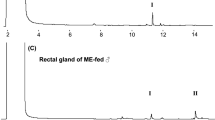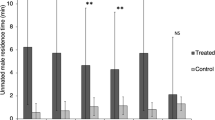Abstract
The attraction of female and male Bactrocera papayae to conspecific males fed with methyl eugenol (ME) and female attraction to male synthetic sex pheromone, trans-coniferyl alcohol (CF), were evaluated in a wind tunnel. Earlier and greater attraction were exhibited by both females and males to ME-fed than to non-ME-fed males as dusk approaches. Males increased their precopulatory behavior (i.e., wing fanning and mounting) during the period of higher attractancy. These data confirm that the consumption of ME enhances the mating competitiveness of males and suggest that ME also functions as a precursor to the male sex and aggregation pheromones. Three phenylpropanoid compounds biosynthesized from ME, coniferyl alcohol, 2-allyl-4,5-dimethoxyphenol, and 3,4-dimethoxycinnamyl alcohol, were detected in male rectal gland along with an endogenous rectal compound, N-(3-methylbutyl) acetamide. When offered singly to the females, coniferyl alcohol was found to be most attractive.
Similar content being viewed by others
REFERENCES
Emlen, S. T., and Oring, L. W. 1977. Ecology, sexual selection and the evolution of mating systems. Science 197:215–223.
Fetcher, M. T., and Kitching, W. 1995. Chemistry of fruit flies. Chem. Rev. 95:789–828.
Jakubas, W. J., Shah, P. S., and Mason, J. R. 1992. Avian repellency of coniferyl and cinnamyl derivatives. Ecol. Appl. 2:147–156.
Jones, O. T., Lomer, R. A., and Howse, P. E. 1981. Responses of male Mediterranean fruit flies, Ceratitis capitata to trimedlure in a wind tunnel of novel design. Physiol. Entomol. 6:175–181.
Kennedy, J. S., and Marsh, D. 1974. Pheromone-regulated anemotaxis in flying moths. Science 184:999–1001.
Kobayashi, R. M., Ohinata, K., Chambers, D. L., and Fujimoto, M. S. 1978. Sex Pheromones of the Oriental fruit fly and the melon fly: Mating behavior, bioassay method, and attraction of females by live males and by suspected pheromone glands of males. Environ. Entomol. 7:107–112.
Metcalf, R. L. 1990. Chemical ecology of Dacinae fruit flies (Diptera: Tephritidae). Ann. Entomol. Soc. Am. 83:1017–1030.
Nishida, R. 1996. Pheromonal communication in the Oriental fruit moth and Oriental fruit fly, pp. 102–113, in K. S. Boo, K. C. Park, and J. K. Jung (eds.). Insect Pest Control with Pheromones. Korean Society of Applied Entomology, Suwon, Korea.
Nishida, R., and Fukami, H. 1990. Sequestration of distasteful compounds by some pharmacophagous insects. J. Chem. Ecol. 16:151–164.
Nishida, R., Tan, K. H., Lajis, N. H., Sukari, A. M., Takahashi, S., and Fukami, H. 1988a. Accumulation of phenylpropanoids in the rectal gland of the Oriental fruit fly, Dacus dorsalis. Experientia 44:534–536.
Nishida, R., Tan, K. H., and Fukami, H. 1988b. cis-3,4–Dimethoxycinnamyl alcohol from the rectal glands of male Oriental fruit fly, Dacus dorsalis. Chem. Exp. 3:207–210.
Perkins, M. V., Fletcher, M. T., Kitching, W., Drew, R. A. I., and Moore, C. J. 1990. Chemical studies of rectal gland secretions of some species of Bactrocera dorsalis complex of fruit flies (Diptera: Tephritidae). J. Chem. Ecol. 16:2475–2488.
Robacker, D. C., and Hart, W. G. 1986. Behavioral responses of male and female Mexican fruit flies, Anastrepha ludens, to male-produced chemicals in laboratory experiments. J. Chem. Ecol. 12:39–47.
Shelly, T. E., and Dewire, A. M. 1994. Chemically mediated mating success in male Oriental fruit flies (Diptera: Tephritidae). Ann. Entomol. Soc. Am. 87:375–382.
Steiner, L. F., Mitchell, W. C., Harris, E. J., Kozuma, T. T., and Fujimoto, M. S. 1965. Oriental fruit fly eradication by male annihilation. J. Econ. Entomol. 58:961–964.
Tan, K. H. 1985. Estimation of native populations of male Dacus spp. by using Jolly's stochastic method using a new designed attractant trap in a village ecosystem. J. Plant Prot. Trop. 2:87–95.
Tan, K. H. 1996. Chemical ecology of fruit flies, Bactrocera species—an update, pp. 36–46, in T. H. Chua and S. G. Khoo (eds.). Problems and Management of Tropical Fruit Flies. The Working Group on Malaysian Fruit Flies, Kuala Lumpur.
Tan, K. H., and Lee, S. L. 1982. Species diversity and abundance of Dacus (Diptera: Tephritidae) in five ecosystems of Penang, West Malaysia. Bull. Entomol. Res. 72:709–716.
Tan, K. H., and Nishida, R. 1992. Fruit fly allomones against predation by lizard. Proc. Natl. IRPA Semin. 1:237–238.
Tan, K. H., and Nishida, R. 1996. Sex pheromone and mating competition after methyl eugenol consumption in Bactrocera dorsalis complex, pp. 147–153, in B. A. McPheron and G. J. Steck (eds.). Fruit Fly Pests: A World Assessment of Their Biology and Management, St. Lucie Press, Port St. Lucie, Florida.
Tan, K. H., Kirton, L. G., and Serit, M. 1987. Age response of Dacus dorsalis (Hendel) to methyl eugenol in (a) a wind tunnel and (b) traps set in a village, and its implication to population estimation, pp. 425–432, in A. P. Economopoulos (ed.). Fruit Flies. G. Tsiveriotis Ltd., Athens.
Author information
Authors and Affiliations
Rights and permissions
About this article
Cite this article
Hee, A.KW., Tan, KH. Attraction of Female and Male Bactrocera papayae to Conspecific Males Fed with Methyl Eugenol and Attraction of Females to Male Sex Pheromone Components. J Chem Ecol 24, 753–764 (1998). https://doi.org/10.1023/A:1022302605357
Issue Date:
DOI: https://doi.org/10.1023/A:1022302605357




